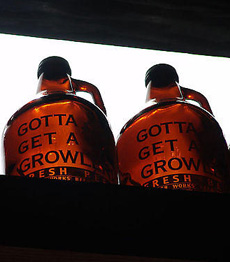BEER: Growlers Are Better

Growlers are the new “in” and green |
“Growler” doesn’t sound too friendly. But up through the 1890s, it was a pretty amiable half-gallon glass jug used to transport draft beer home from the tavern.
Thanks to the growth of craft beer, there’s a growler resurgence in the United States. You can find them at breweries and brewpubs that sell take-out beer: Take-home growlers are filled from the tap. Some homebrewers use growlers as well, as an alternative to kegs or standard bottles for carbonating and storing beer. In the old days growlers had hinged porcelain gasket caps. Today a screw-on cap is as likely (and less expensive). A properly sealed growler will hold carbonation indefinitely, like any other sealed beer bottle. And it’s more economical to buy beer in a growler than go through many smaller bottles. Most places that sell growlers will re-fill them for you. |
|
| Why “growler?” As the story goes, in the late 19th century, before the appearance of the glass growler jug, fresh beer was carried home from the local tavern in a galvanized, lidded tin pail. The claim is that the sound made by the carbon dioxide escaping through the lid as the beer sloshed back and forth sounded like a growl.
Expect to see more growlers (glass jugs, not tin pails) as craft beer fans demand to take home brews on tap. One of the newer Whole Foods Markets in our area sells a reusable growler filled with your choice of beers on tap—a constantly changing selection. When the growler is empty, bring the growler back for a refill and pay for the beer only. In addition to being able to try fresh microwbrews that aren’t available in bottles, the idea of reusable bottles that can be refilled time after time—instead of going into landfill every time—is appealing. In fact, Whole Foods market now offers 32-ounce growlers in addition to the 64-ounce.
|
||


